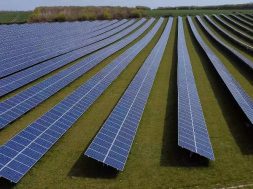
Fraunhofer ISE CalLab PV Modules’ measurement precision internationally confirmed
At 1.3 percent measurement precision, the accredited calibration laboratory of the Fraunhofer Institute for Solar Energy Systems ISE achieved a record value. Measurement repeatability is 0.4 percent. Germany’s national accreditation body DAkkS has confirmed this value according to DIN EN ISO/IEC 17025:2005. The excellent measurement precision of CalLab PV Modules was also proven in a recent comparison of PV module calibrations between the four best-known calibration laboratories worldwide. For PV power plant investors, the precise calibration of PV modules translates into more exact yield predictions and thus lower financial risks. PV manufactures require high measurement precision to ensure the highest-level quality assurance in production and the power measurements of their products.
For the international comparison, two standard and two high-efficiency silicon PV modules were measured by each of the four participating international reference laboratories. In addition to the CalLab PV Modules of Fraunhofer ISE in Freiburg, Germany that initiated and coordinated the comparison, three other laboratories were involved: the European Solar Test Installation (ESTI) of the European Commission’s Joint Research Centre (Ispra, Italy), the Research Center for Photovoltaics of the National Institute of Advanced Industrial Science and Technology (AIST; Tsukuba, Japan) and the National Renewable Energy Laboratory (NREL; Golden, CO, USA). Calibration measurements of the short-circuit current, the open-circuit voltage, the power at maximum power point and the fill factor were compared.
At the end of the exercise, all modules were sent back to CalLab PV Modules where they were re-measured. For the crystalline PV modules, the measured values showed deviations within a range of ±0.9 percent, whereas for the high-efficiency modules the deviations lay within only ± 0.2 percent in part. Even the maximum measured deviation of 0.9 % lay well below the value of the previous international comparison (2014: 1.3 percent). The JRC Ispra published the newest results in the October issue of “Solar Energy,” the official journal of the International Solar Energy Society®.
High Reliability on International Level
“This international Round-Robin provides comparative information about the calibration results of the four laboratories with respect to different PV technologies and measurement precision. We could demonstrate that the measurement methods for both crystalline silicon standard modules and high-efficiency modules are well established, thus providing the customer with a very high reliability,” says Frank Neuberger, Head of the Group CalLab PV Modules. “On the international level, CalLab PV Modules has proven its excellent standing among the most renowned calibration laboratories in the world.”
As accredited calibration laboratory, CalLab PV Modules of Fraunhofer ISE provides comprehensive calibration services for PV modules and reference cells. In addition, the laboratory supports PV power plant investors by offering customized testing procedures, assistance in selecting suppliers, quality assurance in purchasing as well as power monitoring during operation. The customers profit from the high measurement precision of the calibration laboratory at Fraunhofer ISE. Also module manufacturers rely on precisely measured reference modules: for reducing measurement uncertainty in the production and for giving power ratings with low tolerance in their data sheets. To stay abreast with the newest developments in module technology, CalLab PV Modules has set up a worldwide unique test rig specially designed to calibrate bifacial PV modules.
CalLab PV Modules at the EUPVSEC
September 26, 2017 from 5pm – 6:30 pm
Visual Presentation: “IV Measurement of Bifacial Modules: Bifacial vs. Monofacial Illumination”
Poster Area 5BV.4.32
















